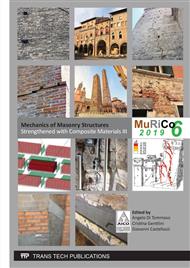[1]
ACI 549.4 R - 13. Guide to Design and Construction of Externally Bonded Fabric-Reinforced Cementitious Matrix (FRCM) Systems for Repair and Strengthening Concrete and Masonry Structures (2013).
DOI: 10.1016/j.prostr.2018.11.027
Google Scholar
[2]
CNR-DT 215/2018. Istruzioni per la progettazione, l'esecuzione ed il controllo di interventi di consolidamento statico mediante l'utilizzo di compositi fibrorinforzati a matrice inorganica (2018).
Google Scholar
[3]
V.M. Karbhari, J.W. Chin, D. Hunston, B. Benmokrane, T. Juska, R. Morgan, Durability gap analysis for fiber-reinforced polymer composites in civil infrastructure, J. Compos. Constr 7 (2003) 238-247.
DOI: 10.1061/(asce)1090-0268(2003)7:3(238)
Google Scholar
[4]
F. Micelli, A. Nanni, Durability of FRP rods for concrete structures. Construction and Building Materials 18 (2004) 491-503.
DOI: 10.1016/j.conbuildmat.2004.04.012
Google Scholar
[5]
F. Micelli, J.J. Myers, Durability of FRP-confined concrete. Proceedings of the Institution of Civil Engineers - Construction Materials 161 (2008) 173-185.
DOI: 10.1680/coma.2008.161.4.173
Google Scholar
[6]
F. Micelli, R. Mazzotta, M. Leone, M.A. Aiello, Review Study on the Durability of FRP-Confined Concrete, Journal of Composites for Construction 19 (2015).
DOI: 10.1061/(asce)cc.1943-5614.0000520
Google Scholar
[7]
J.R. Cromwell, K.A. Harries, B.M. Shahrooz, Environmental durability of externally bonded FRP materials intended for repair of concrete structures, Construction and Building Materials 25 (2011) 2528-2539.
DOI: 10.1016/j.conbuildmat.2010.11.096
Google Scholar
[8]
D. Arboleda, S. Babaeidarabad, C. Dilaurenzio Hays, A. Nanni, G. Fisher, E. Scholar, Durability of fabric reinforced cementitious matrix (FRCM) composites (2014).
Google Scholar
[9]
A. Nobili, C. Signorini, On the effect of curing time and environmental exposure on impregnated Carbon Fabric Reinforced Cementitious Matrix (CFRCM) composite with design considerations, Composites Part B 112 (2017) 300-313.
DOI: 10.1016/j.compositesb.2016.12.022
Google Scholar
[10]
J. Donnini, F. De Caso, V. Corinaldesi, G. Lancioni, A. Nanni, Fabric-reinforced cementitious matrix behavior at high-temperature: Experimental and numerical results, Composites Part B 108 (2017) 108-121.
DOI: 10.1016/j.compositesb.2016.10.004
Google Scholar
[11]
I. Colombo, M. Colombo, A. Magri, G. Zani, M. Prisco, Textile reinforced mortar at high temperatures, Applied mechanics and materials 82 (2011) 202-207.
DOI: 10.4028/www.scientific.net/amm.82.202
Google Scholar
[12]
A. Nobili, Durability assessment of impregnated Glass Fabric Reinforced Cementitious Matrix (GFRCM) composites in the alkaline and saline environments, Construction and Building Materials 105 (2016) 465-471.
DOI: 10.1016/j.conbuildmat.2015.12.173
Google Scholar
[13]
AC 434. Acceptance criteria for masonry and concrete strengthening using fiber-reinforced cementitious matrix (FRCM) composite systems (2011).
DOI: 10.14359/51702356
Google Scholar
[14]
S. De Santis, G. de Felice, Tensile behaviour and durability of mortar-based strengthening systems with glass-aramid textiles, Key Engineering Materials 624 (2015) 346-353.
DOI: 10.4028/www.scientific.net/kem.624.346
Google Scholar
[15]
A. Borri, G. Castori, M. Corradi, R. Sisti, Ageing Problems of GFRP Grids Used for Masonry Reinforcement, Key Engineering Materials 624 (2015) 413-420.
DOI: 10.4028/www.scientific.net/kem.624.413
Google Scholar
[16]
F. Micelli, M.A. Aiello, Residual tensile strength of dry and impregnated reinforcement fibres after exposure to alkaline environments, Composites Part B: Engineering 159 (2019) 490-501.
DOI: 10.1016/j.compositesb.2017.03.005
Google Scholar
[17]
ASTM D7705/D7705M - 12. Standard Test Method for Alkali Resistance of Fiber Reinforced Polymer (FRP) Matrix Composite Bars used in Concrete Construction (2015) 1–5.
DOI: 10.1520/d7705_d7705m
Google Scholar
[18]
EN 1015-11:1999. Methods of test for mortar for masonry Part 11: Determination of flexural and compressive strength of hardened mortar (2006) 1–12.
DOI: 10.3403/01905442u
Google Scholar
[19]
Consiglio Superiore dei Lavori Pubblici. Linea Guida per la identificazione, la qualificazione ed il controllo di accettazione di compositi fibrorinforzati a matrice inorganica (FRCM) da utilizzarsi per il consolidamento strutturale di costruzioni esistenti (2018) 1-5.
DOI: 10.3221/igf-esis.12.04
Google Scholar
[20]
ISO 3341:2000-05-01. Textile glass - Yarns - Determination of breaking force and breaking elongation (2000) 1-7.
DOI: 10.3403/02000514
Google Scholar


